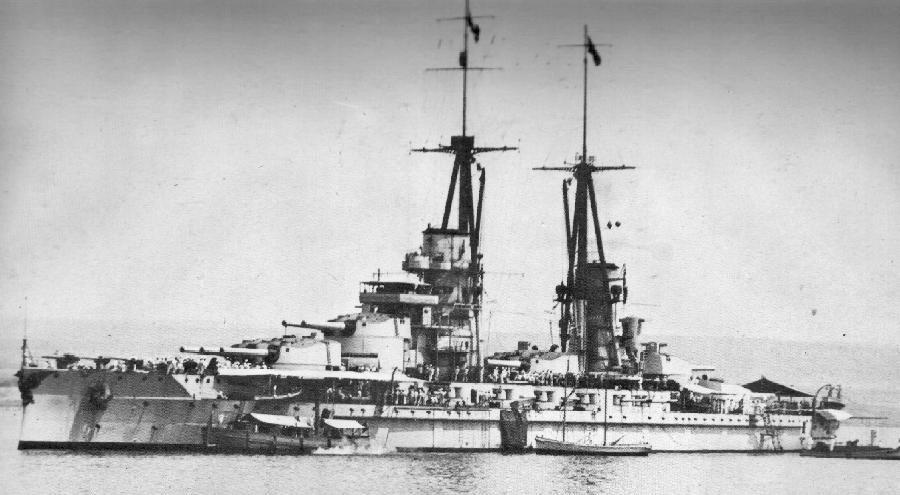Sunday Battleship Blogging: RN Giulio Cesare
 Giulio Cesare (Julius Caesar) was the third battleship commissioned by the Italian Navy. When built she was a respectably armed unit, 24000 tons, 13 12″ guns in three triple and two twin turrets, and could make 22 knots. Like most Italian battleships, Giulio Cesare had relatively light armor.
Giulio Cesare (Julius Caesar) was the third battleship commissioned by the Italian Navy. When built she was a respectably armed unit, 24000 tons, 13 12″ guns in three triple and two twin turrets, and could make 22 knots. Like most Italian battleships, Giulio Cesare had relatively light armor.
The job of the Italian Navy in World War I was to counter the Austrian Navy. The Regina Maria did this job very well; the Austrian Navy left port once, and lost a battleship in its brief foray. The job of watching a fleet that never leaves port is not an exciting one, however, and Giulio Cesare had an uneventful war. Her sister, Leonardo Da Vinci, was blown up by Austrian frogmen in 1916. Her sole mission before World War II was to bombard the Greek island of Corfu during a diplomatic dispute.
The Washington Naval Treaty prevented most of the great powers from building new battleships during the interwar period. So, instead of new construction, most countries rebuilt old ships. In some cases the changes were minor; most US battleships lost their cage masts, for example. The Japanese, never quite satisfied, reconstructed many of their battleships twice. The British put off the reconstruction too long, and went into the war with several ships (such as the battlecruiser Hood) unmodified from their original form.
Giulio Cesare went through a process that was less reconstruction than full transformation. After a four year modernization process, she emerged as a 29000 ton unit, carrying 10 13″ guns in two twin and two triple turrets, and capable of making 28 knots. The speed increase in particularly turned Giulio Cesare into a useful and dangerous unit, although her light armor continued to make confrontations with enemy battleships a dangerous proposition.
The problem of the Italian Navy in World War II had less to do with the ships than with the management. Whereas the Italians ought to have challenged the Royal Navy for control of the Mediterranean (especially given the British commitments in the Atlantic and the Pacific), the fleet rarely left port, a fact that the Royal Navy took advantage of on November 11, 1940, when the aircraft of a single light carrier devastated the Italian naval anchorage at Taranto. Giulio Cesare escaped damage, but her sister Cavour was sunk, and several other ships were damaged.
Giulio Cesare ran convoy escort missions until 1942, when the Italian Navy withdrew her from active operations because of increasing Allied dominance in the Mediterranean. Again, this was a poor decision, as greater pressure on the Allies in the Med could have helped the Axis war effort in other areas. Following the Italian surrender in September of 1943, Giulio Cesare and several other battleships surrendered to the Royal Navy at Malta, where the ships remained until the end of the war.
Giulio Cesare was returned to Italy following the war. The Allied terms were relatively merciful. The Soviets, however, were less interested in accomodation. In 1948, Giulio Cesare was transferred, as war reparations, to the Soviet Union. In a 
In late October 1955, Novorossiysk exploded and sank at anchor in Sevastopol. The cause remains unclear. Most likely, a magnetic mine dropped by Germany during World War II attached itself to the bottom of her hull and exploded. 608 Russian crewmen died, largely because of the ineptitude of the Soviet captain who thought that she would settle on the bottom rather than capsize. Other theories of Novorossiysk’s end persist, however. One suggests that an Italian special forces team attached explosives to the ship and blew it up out of revenge. It is rumored that several Italian frogmen received high decorations for mysterious reasons in the lat 1950s. Another theory suggests that the Italians planted explosives in the ship upon the transfer, although why they would set the timer for seven years escapes me. Finally, one theory suggests that Soviet intelligence blew the ship up with the purpose of blaming Turkey for the tragedy and sparking a war. The the sinking was concealed from the world puts this explanation into question, of course.


